Hundreds of pilot whales dead on Tasmania’s west coast after mass stranding
Rescuers have managed to save a significant number of pilot whales in a single day after hundreds were stranded on Tasmania’s west coast.
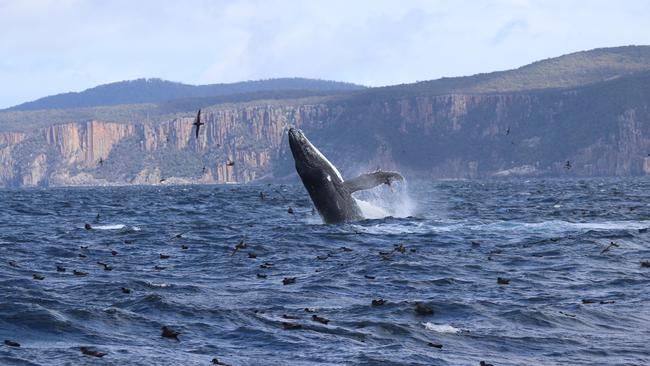
Animals
Don't miss out on the headlines from Animals. Followed categories will be added to My News.
Wildlife experts have managed to save 32 pilot whales after a mass stranding left nearly 200 whales dead on a beach in Tasmania.
A crew of 50 skilled workers and volunteers undertook the mammoth effort on Thursday to release and refloat the whales who had become stranded on the west coast.
Tasmania Parks and Wildlife Service regional operations manager Brendon Clark said rescuers had overcome “challenging conditions” to successfully rescue so many whales in a single day.
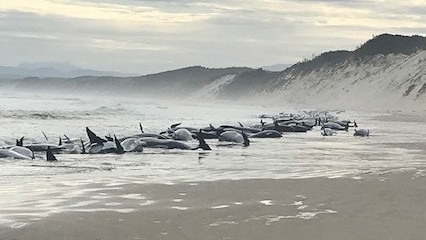
Following the huge rescue mission, several whales restranded themselves on Ocean Beach on Thursday night. One of the whales died and another had to be euthanised for animal welfare reasons.
Mr Clark said Friday’s efforts would be spent on rescuing the three remaining pilot whales stranded on the shore.
“The priority today is to rescue and release the remaining surviving whales along with any others that may restrand, before the team begins to focus on removal and disposal operations of about 200 deceased whales,” he said.
On Wednesday, around 230 whales became stranded at the entrance to Macquarie Harbour near Strahan on Tasmania’s west coast.
Mr Clark said only 35 whales had survived the night. He blamed the exposed conditions.
“Unfortunately, we do have a high mortality rate for this particular stranding – that’s predominantly due to the exposed conditions out on Ocean Beach,” he said.

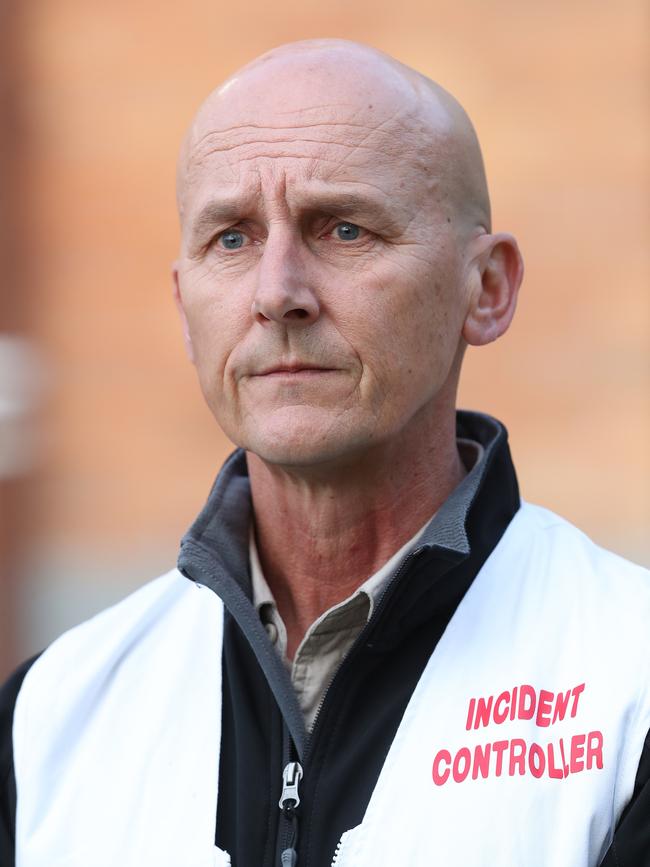
“The environmental conditions, the surf out there on the exposed west coast, is certainly taking its toll on the animals.”
After a day spent triaging the whales to determine which animals had the best chance of survival, rescue crews were in action on Thursday trying to enact their daring operation.
Around 50 experts and experienced personnel continue to be in involved in the heavy-duty mission, including volunteers from three local aquaculture organisations, State Emergency Services and parks employees.
“The primary focus this morning is on rescuing and releasing the surviving animals,” Mr Clark reiterated.
The remaining whales will be gently rolled onto large whale mats and carried into a trailer, which will be lined with mattresses for comfort.
A mechanical aid will help the crews lift the whales into the trailers, a feat normally achieved by muscle and willpower alone.
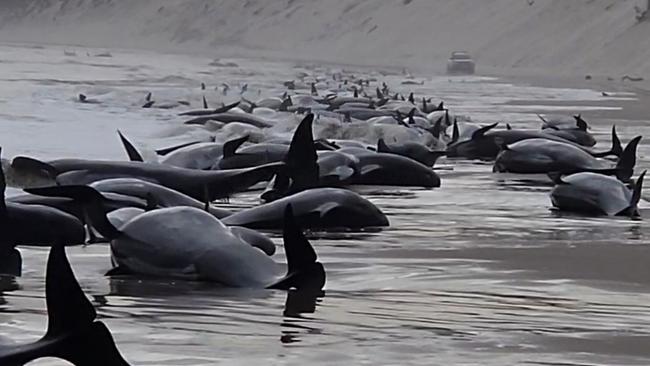
Kris Carlyon, operations manager of the marine conservation program for Natural Resources and Environment Tasmania, said the device would make the rescue more efficient.
“We’re really confident that it’s going to help speed things up a bit and also to make sure we’re managing fatigue,” he said.
“We have animals that are essentially high and dry on the sand. These animals may weigh as much as 2.5 tonnes. They’re big and they’re heavy.”
The pilot whales will then be ferried out to deeper waters, where they would then be set free.
The marine conservation program manager said there would be further whale casualties throughout Thursday as crews raced the clock.
“I think it’s inevitable that we may lose a few more of these animals,” Mr Carlyon said.
“They have been stranded for over 24 hours. They are in a highly exposed and stressful location. They’re not semi-buoyant.”
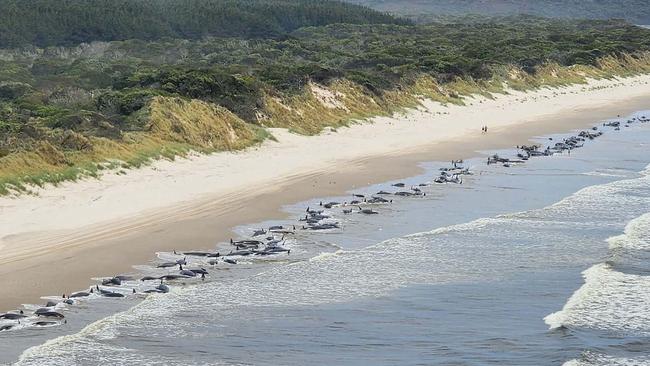
Rescue crews worked hard throughout Thursday to “maximise success” and save as many whales as possible. Mr Carlyon said he was “optimistic” about the number of whales the crews could rescue on Thursday.
“I’d be confident that we can put a real dent in those 35 animals and start moving the majority by today,” he said.
Both men admitted seeing the whales stranded en masse was “confronting” and “difficult”, and they said they would need to take steps to ensure it didn’t happen again.
“We are conscious that some of these animals may rebeach themselves and so we’ll be monitoring that,” Mr Clark said.
Whales are being kept moist and cool until they can be moved.Friday’s cold and rainy conditions were ideal for the surviving whales who are at risk of overheating on shore, Mr Carlyon said.
Once local crews have rescued all the living whales on Ocean Beach, they will begin to focus on the disposal and removal of nearly 200 dead whales.
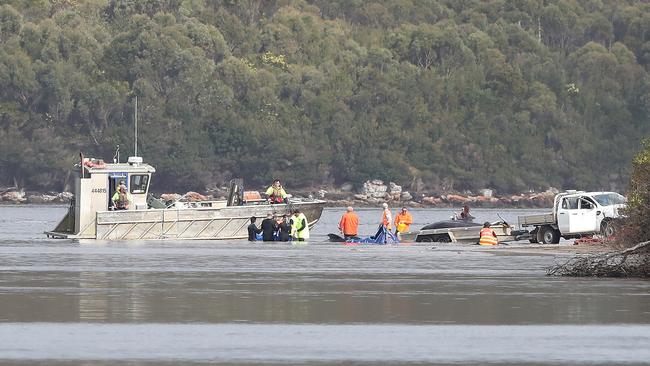
Mr Clark said the disposal of the carcasses would take “significantly more time”, which he estimated to be a couple of days at least.
The deceased whales will be carried out onto ocean and given an at-sea burial in deep waters.
Experts made numerous comparisons with the largest mass whale stranding in Australia’s history, which happened almost exactly two years ago.
In September 2020, approximately 450 pilot whales were stranded in the same area and 100 were able to be rescued.
This rescue will be harder because the whales aren’t buoyant and the location is more exposed, but rescuers say there was a “huge amount of learning” to come from the 2020 event.
“It’s come together a lot faster and more experienced now,” Mr Carlyon said.
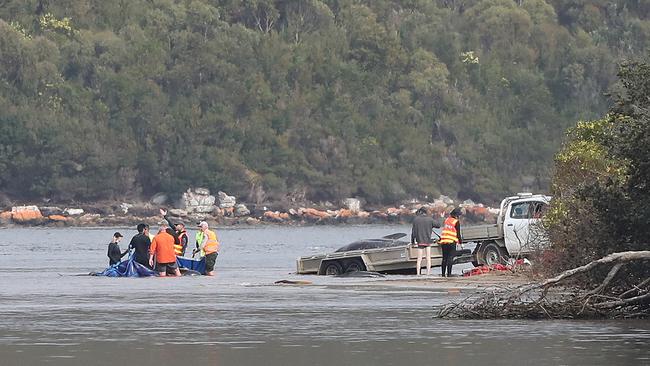
He speculated there may be so many beachings in the area because the shallow water in the Macquarie Heads area could interfere with a whale’s echolocation system to create a “whale trap”.
Mr Clark said Friday, Saturday and possibly Sunday will be spent recovering whale carcasses and taking them out to the deep ocean.
The mass stranding comes only a few days after 14 sperm whales died after becoming beached on King Island.
Originally published as Hundreds of pilot whales dead on Tasmania’s west coast after mass stranding



